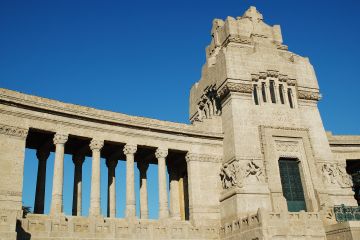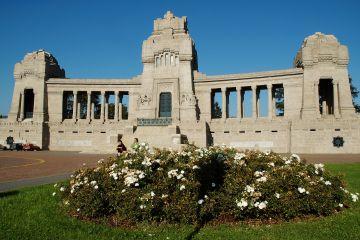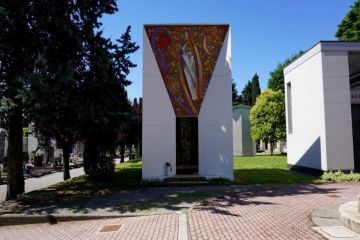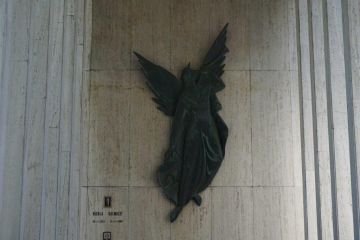“There is no definitive separation while there is memory”
So wrote Isabel Allende, and the cemetery is the place of memory, the concrete sign of the passage of those who no longer exist in this earthly life.
The Monumental Cemetery of Bergamo is the city’s main holy field. It was designed by two great personalities of the last century, architect Ernesto Pirovano and sculptor Ernesto Bazzarro and was constructed between 1896 and 1913.
Cited in the writings of the time as the greatest work in the history of the city as hundreds of workers worked on this project. It is also remembered as the first building in Bergamo where reinforced concrete was used.
It is located in the Borgo Palazzo district and with its eclectic style, it is a fascinating artistic place just outside the city centre.
Once you have gone through the entrance, you will be facing a true open-air museum.
Explore the funerary art. Preserved inside are greatly important works from an architectural and artistic point of view. Everything will tell you about the city’s history from last century. A place of historical and artistic memory of the territory. Thanks to the wealth of the heritage of sculptures and architecture of the twentieth century, it is possible to take a journey through time.
The artists of the shrines and monuments are among the most important artistic figures of the last century. Attilio Nani, Trento Longaretti, Piero Boris, Giacomo Manzù, Giovanni Muzio, Elia Fornoni and Luigi Angelini, just to name a few.
Walking along its avenues, you will find yourself thus retracing the variations of Bergamo and its inhabitants. The sculptures on the headstones and the portraits in the family chapels will show you the men and women who lived and made the history of the city.
In the majestic architecture found at the entrance of the Monumental Cemetery there is the famedio, a funerary temple dedicated to the memory of important people. In fact, burial in this place is a privilege that the city gives to those who distinguished themselves during their life and gave pride and glory to the city. Angelo Mazzi is buried here, a scholar of art and history from Bergamo and director of the Angelo Maj Library. There is also the literary Ciro Caversazzi, famous for having given a speech at the Riccardi Theatre when he was only 17 years old, during a commemoration to Garibaldi, and active in fight for the right to education between the fourteenth and twentieth centuries. The Library in Via Tasso is dedicated to him. Also, the composers Alessandro Nini and Antonio Cagnoni are buried here and the last Bergamasco to which the honour of the famedio was granted is the Maestro Gianandrea Gavazzeni. He was a conductor in the most important Italian theatres like the Fenice in Venice and La Scala in Milan.
Enrico Rastelli, considered the father of modern juggling, also rests in the Monumental Cemetery of Bergamo. In his chapel, there is a statue by sculptor Gianni Remuzzi depicting a smiling Rastelli playing with three soccer balls, one of which is balanced on one finger.
Other famous faces buried here are the sculptor Gianni Remuzzi, painter Trento Longaretti, artist Mario Sironi, Sebastiano Zilioni, mayor of the city between 1914 and 1920 and a prominent figure in the history of Bergamo and Pio Manzù, son of the sculptor Giacomo. There is also internationally renowned designer, Aurelio Guzzoni, director of the historic Grand Hotel Moderno in the 1920s and one of the founders of Pro Bergamo, association with the aim of promoting the beauties of the Bergamo area. The Galizzi family are also here, which includes some of the important artists at the turn of the nineteenth and twentieth centuries. In the Galizzi Chapel there is Enrico Scuri, historical director of the Accademia Carrara. The cemetery houses the remains of footballer Piermario Morosini, who died on the field at 25 due to a rare genetic disease and Nicolò Trussardi, designer and patron of the well-known clothing brand.
There are many important works of art with a strong emotional impact inside the Cemetery but you will marvel at the sculpture “Circle of Life” by Egidio Sartori placed on the Badoglio Tomb. A large circle composed of seven figures, representing the various stages of existence, symbolising the eternity of the cycle of time that is always renewed through birth, growth and death.
From an architectural point of view the most impressive chapel is certainly the Callioni Chapel and one of the oldest monuments is certainly in the Chapel belonging to the Fontana family, and today the Nosari Tomb, where notary Peppino Nosari rests. In the green, there is the Pisoni Gabrieli Tomb, where the sculptural group is the work of Elia Ajoulfi. The large bronze work depicts three nuns side by side forming a semicircle. The three sculptures are a rare iconographic example in the Cemetery. Their shape is synthetic, characterised by sharp cuts giving them an almost geometric appearance and tending to abstraction. The sisters so carved are mute witnesses of the passage of souls.
The Lanzani Chapel holds a unique sculpture. A farmer is depicted carrying a plow pulled by oxen and in the background you can glimpse a mountain and the tree on the left delimits the scene, occupying the whole space and performing the function of a frame. In the Goisis Chapel, where the Knight of Labour rests and historical Managing Director of “Acciaierie e Ferriere Lombarde Falk” Lodovico Goisis, there is a sculpture by Piero Cattaneo with unusual iconography. In the lower left you can see an open sarcophagus from which emerges a corpse wrapped in bandages and on the right some symbols of the passion of Christ, some veiled souls and the name of the Goisis family. At the top, there is a figure raised to the sky wrapped in a large drapery, representing the resurrection.
On the back door, placed to complete the exedra there is the Mausoleum of the Fallen. Project by Ernesto Pirovano, it was built in 1937 to remember the fallen soldiers.
Along with other marbles, Brembate ceppo is present in external coverings, as a reference to the main facade of the Monumental Cemetery and the only decorative element is a marble bas-relief by Zandobbio depicting Victory encircling fallen soldiers with a laurel wreath.









Post a comment